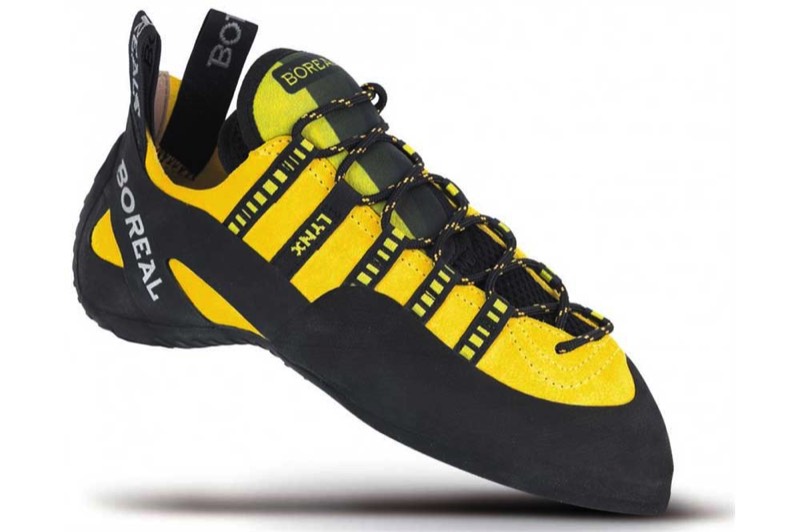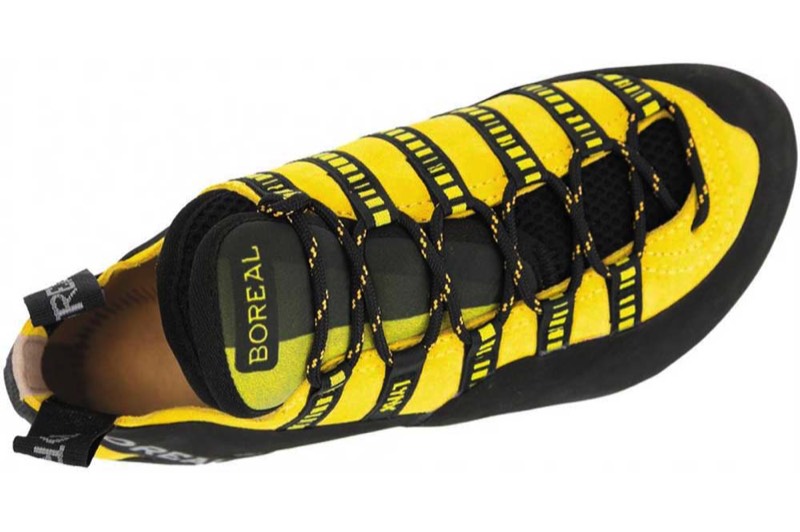The 2015 Boreal Lynx – Combining precision, comfort and exceptional all-round performance.
Very rarely am I as impressed with a climbing shoe as I am with the new Boreal Lynx. This is a shoe that (depending on how it’s sized) can easily transition between longer moderate routes to high-end technical sport climbs. Heck, the legendary Ben Moon even used them during his recent redpoint of Rainshadow 5.14d.

Boreal Lynx
But it’s not just the Lynx’s versatility and performance that impressed me. I was also equally fascinated by how Boreal had managed to merge these seemingly conflicting performance characteristics. You see, on the surface, the Lynx does not seem particularly performance-oriented. But once you spend some time climbing with it, you realize that Boreal has nailed a number of small design details, which together create a shoe that’s greater than the sum of its parts.
The first thing most climbers will notice is the new Lynx last that features a wider (more comfortable) forefoot as well as a better-fitting lower volume heel. These fit updates not only improve the shoe’s overall comfort, but they also create a locked-in fit for more control when edging or heel hooking on challenging routes.
Also new for this season is a slightly more asymmetric last that (at least for me) offers a better fit and provides more power and precision over the big toe. This results in better control on small edges without the foot-contorting fit found on some more aggressively asymmetric shoes. Again, this is a minor tweak from last year, but it does result in a noticeable improvement in performance.
The first thing most climbers will notice is the new Lynx last that features a wider (more comfortable) forefoot as well as a better-fitting lower volume heel. These fit updates not only improve the shoe’s overall comfort, but they also create a locked-in fit for more control when edging or heel hooking on challenging routes.
Also new for this season is a slightly more asymmetric last that (at least for me) offers a better fit and provides more power and precision over the big toe. This results in better control on small edges without the foot-contorting fit found on some more aggressively asymmetric shoes. Again, this is a minor tweak from last year, but it does result in a noticeable improvement in performance.

Boreal Lynx Lacing
Finally, Boreal has adjusted the offset lacing so that it extends closer to the toes and has added additional nylon lacing straps to prevent excessive shoe-stretch. Initially, these are seemingly trivial updates, but they literally transform how the shoe performs on smaller holds. Not only do they increase precision by preventing unwanted foot movement inside the shoe, but the most forward nylon strap also acts as a bolster for the upper, which further increases power and control on tenuous holds.
And while not necessarily new, Boreal’s latest generation of Zenith rubber is supremely sticky and durable, and offers all-round performance that’s at least as good as any other rubber on the market.
I also want to commend Boreal for building the Lynx shoes with unlined leather for the uppers. While synthetic uppers and linings may prevent some unwanted stretch, they cannot match the foot-conforming fit of real leather. After using the Lynx for a few days, I noticed that they stretched just enough (the nylon straps prevented full-scale stretching) so that they perfectly conformed to my feet.
Other details worth noting include Boreal’s effective V2 rand that applies tension at the heel and mid/forefoot, a comfy neoprene tongue, a sensitive yet supportive midsole and a lower volume women-specific model.
As for where the Lynx excels, it’s pretty much ideal for anything other than super-steep cave climbing (where a softer, more downturned shoe may be more suitable) or wide cracks. Beyond these two situations, the Lynx (when sized accordingly) will work for bouldering, hard sport climbing, plastic-pulling and trad routes. It really is that versatile and effective, and should be a top choice for new or experienced climbers.
And if you don’t believe me, check out this video of Ben Moon sending Rainshadow 5.14d while wearing the Lynx.
And while not necessarily new, Boreal’s latest generation of Zenith rubber is supremely sticky and durable, and offers all-round performance that’s at least as good as any other rubber on the market.
I also want to commend Boreal for building the Lynx shoes with unlined leather for the uppers. While synthetic uppers and linings may prevent some unwanted stretch, they cannot match the foot-conforming fit of real leather. After using the Lynx for a few days, I noticed that they stretched just enough (the nylon straps prevented full-scale stretching) so that they perfectly conformed to my feet.
Other details worth noting include Boreal’s effective V2 rand that applies tension at the heel and mid/forefoot, a comfy neoprene tongue, a sensitive yet supportive midsole and a lower volume women-specific model.
As for where the Lynx excels, it’s pretty much ideal for anything other than super-steep cave climbing (where a softer, more downturned shoe may be more suitable) or wide cracks. Beyond these two situations, the Lynx (when sized accordingly) will work for bouldering, hard sport climbing, plastic-pulling and trad routes. It really is that versatile and effective, and should be a top choice for new or experienced climbers.
And if you don’t believe me, check out this video of Ben Moon sending Rainshadow 5.14d while wearing the Lynx.
You can find out more about the new Lynx and other Broreal products at www.e-boreal.com.


